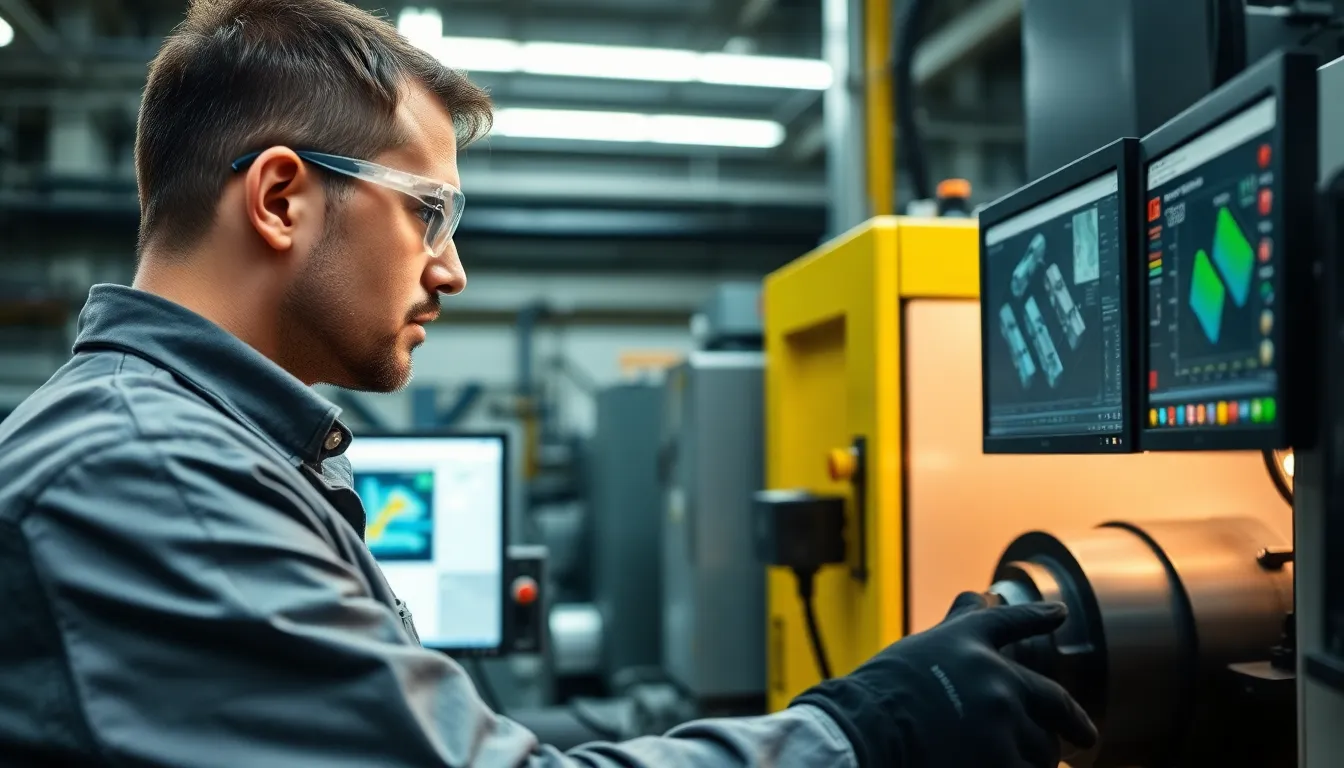In the world of manufacturing, CNC programming software is the unsung hero, quietly transforming raw materials into precision-engineered masterpieces. Imagine a tool that turns your wildest design dreams into reality, all while sipping coffee and avoiding the dreaded human error. Sounds like magic, right? Well, it’s not; it’s just the power of CNC programming at work.
Table of Contents
ToggleOverview of CNC Programming Software
CNC programming software plays a vital role in modern manufacturing processes. This software allows operators to input designs, specifying dimensions and movements for equipment like CNC mills, lathes, and routers. Many programs offer user-friendly interfaces, making it easier for users to create and modify designs without extensive programming knowledge.
Various types of CNC programming software exist, each catering to specific manufacturing needs. Popular choices include CAD/CAM software that combines computer-aided design with computer-aided manufacturing capabilities. These tools streamline the transition from design to production, enhancing efficiency and accuracy.
Additionally, simulation features within these programs allow users to visualize machining processes before execution. This capability minimizes errors by enabling adjustments to be made in a virtual environment. More advanced systems include features for toolpath optimization, which maximize machining speed while ensuring quality.
Cloud-based solutions are gaining traction in the industry as well. Accessing CNC programming software from any internet-enabled device promotes collaboration among teams in different locations. Many solutions also incorporate machine learning algorithms for predictive maintenance and improved operational efficiency.
Choosing the right CNC programming software depends on various factors including price, compatibility with existing machinery, and specific project requirements. Manufacturers must assess their objectives to determine which software best suits their operations and workflow.
Types of CNC Programming Software

CNC programming software comes in various forms to meet different needs in production. Each type plays a specific role in transforming designs into tangible products.
G-Code Generators
G-Code generators convert design files into machine-readable G-Code instructions. These generators allow users to input parameters such as tool paths, speeds, and feeds. Popular options include software like Fusion 360 and Mastercam, which automate this conversion process. Intuitive interfaces make it easy for operators to customize their settings, ensuring precision during machining. Many G-Code generators also feature simulation capabilities to visualize the tool paths before execution, enhancing accuracy and reducing costly errors.
CAD/CAM Software
CAD/CAM software combines design and manufacturing processes into a streamlined solution. Users create detailed 2D or 3D models using computer-aided design tools before transferring them to computer-aided manufacturing environments. Leading software includes SolidWorks and Rhino, known for their robust design functionalities. These platforms facilitate seamless transitions from concept to production, improving efficiency. Advanced CAD/CAM solutions often incorporate features for optimizing toolpaths and minimizing machining time, further enhancing productivity in manufacturing settings.
Key Features of CNC Programming Software
CNC programming software offers several key features that enhance productivity and precision in manufacturing. Operators benefit from intuitive interfaces, strong simulation capabilities, and seamless compatibility with existing systems.
User Interface
User interfaces play a crucial role in CNC programming software. Simplified layouts allow users to input designs without extensive training. Customizable dashboards enhance workflow efficiency, enabling operators to focus on productivity. Drag-and-drop functionality enables quick design adjustments. Visual aids, such as 3D previews, demonstrate design outcomes, helping users avoid errors early in the process.
Simulation Capabilities
Simulation capabilities significantly enhance the CNC programming experience. Real-time visualizations allow users to observe machining processes before actual production. Operators can make adjustments within a virtual environment, minimizing costly mistakes. Many systems incorporate collision detection features, ensuring safe and efficient operations. Predictive analytics can optimize tool paths, contributing to faster and more accurate machining.
Compatibility and Integration
Compatibility and integration are vital for efficient CNC programming software. This software often supports various file formats, allowing seamless data import from design applications. Integration with other manufacturing systems strengthens overall productivity and workflow. Compatibility with different CNC machines ensures versatility in various production environments. Such features promote smoother operations and easier updates, keeping pace with evolving technology.
Benefits of Using CNC Programming Software
CNC programming software provides several key benefits that significantly enhance manufacturing processes. These tools streamline operations, making tasks more efficient while ensuring high precision in product outputs.
Improved Precision
CNC programming software enhances accuracy in machining operations. It reduces human errors by allowing precise input of design specifications and parameters. Users can visualize each step through advanced simulation features, making adjustments before actual manufacturing. Toolpath optimization is crucial, ensuring that movements follow calculated paths without deviation. Operators achieve tighter tolerances in production, resulting in perfectly engineered parts. Metrics indicate that the software often maintains tolerances within ±0.001 inches, increasing overall product quality.
Increased Efficiency
Efficiency rises markedly with CNC programming software. Automating the programming process saves significant time compared to manual coding. Workflow becomes smoother due to user-friendly interfaces that simplify design modifications. Drag-and-drop functionality and instant visual feedback reduce the time spent on adjustments. This combination often leads to a 30% decrease in lead times. Cloud-based solutions enhance collaboration across teams, promoting quick decision-making and flexibility in production scheduling. The end result demonstrates a notable rise in productivity, making manufacturing operations more competitive.
CNC programming software stands as a vital component in modern manufacturing. Its ability to enhance precision and efficiency makes it indispensable for operators looking to streamline their processes. By minimizing human error and optimizing toolpaths, manufacturers can achieve higher quality products while reducing lead times.
The diverse range of software options available allows businesses to select solutions tailored to their specific needs. With advancements in user-friendly interfaces and cloud-based functionalities, collaboration and adaptability in production are easier than ever. Investing in the right CNC programming software not only elevates operational productivity but also positions manufacturers for long-term success in a competitive landscape.



